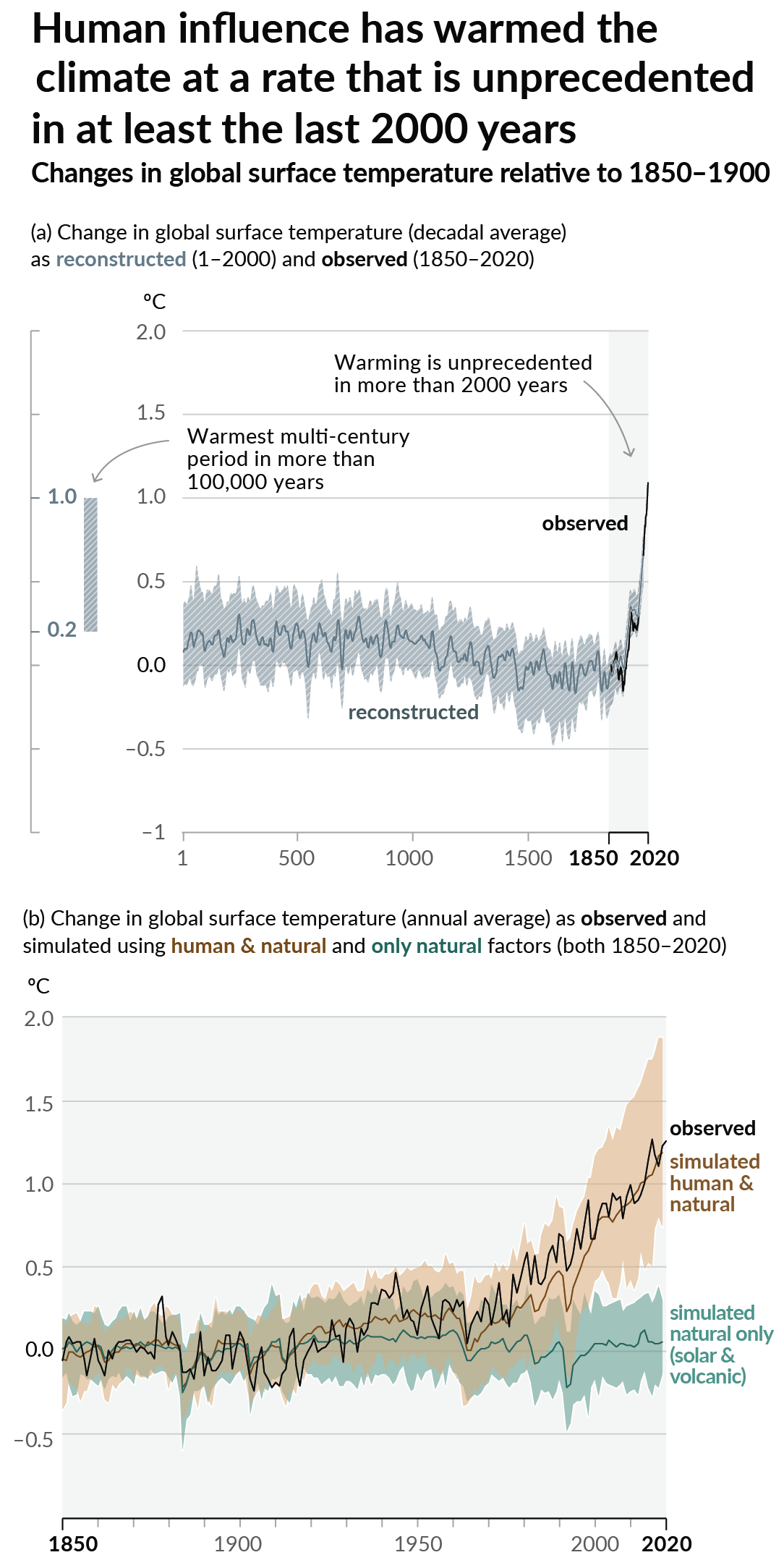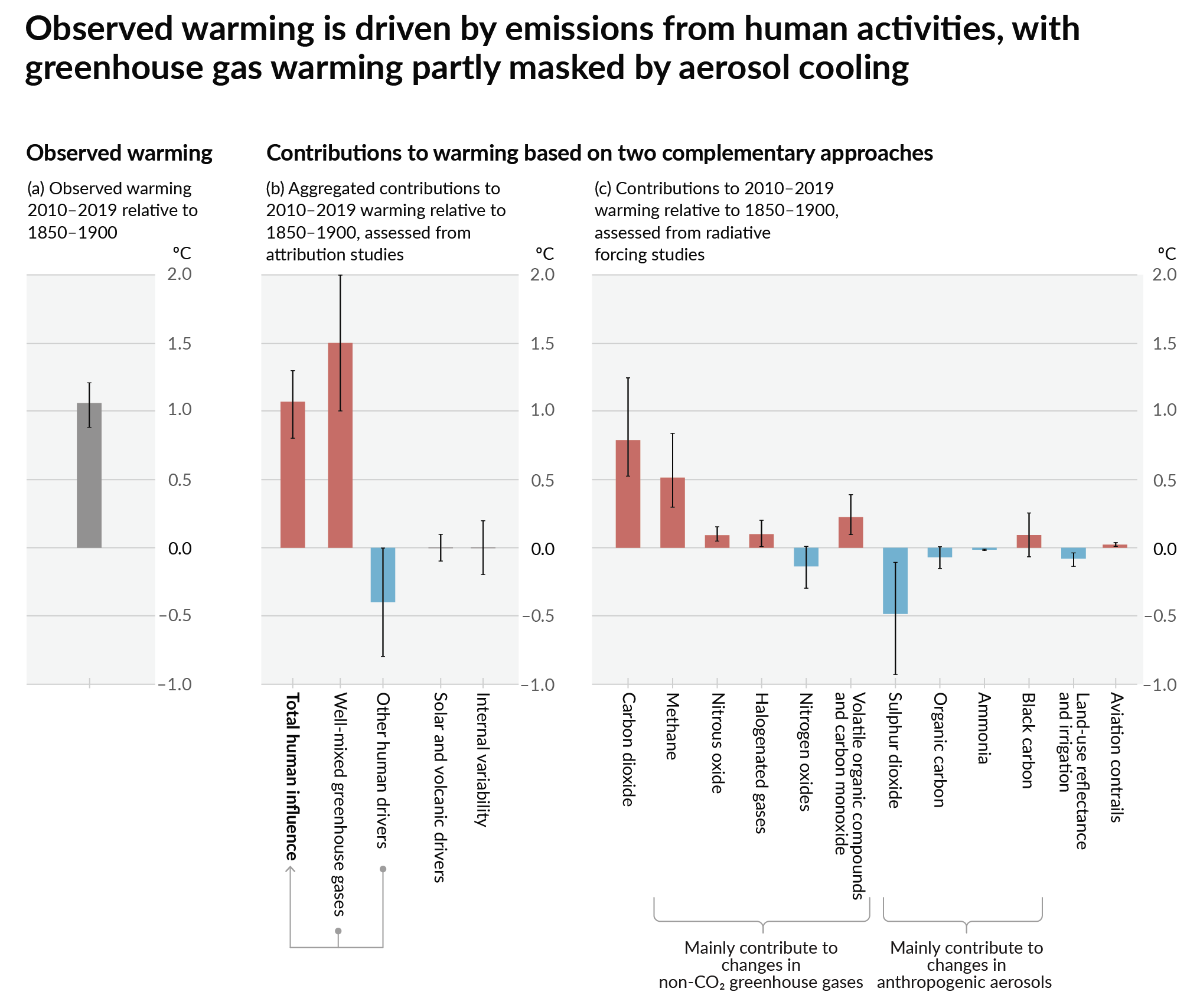462
Eating Meat Is Bad for Climate Change, and Here Are All the Studies That Prove It
(sentientmedia.org)
Discussion of climate, how it is changing, activism around that, the politics, and the energy systems change we need in order to stabilize things.
As a starting point, the burning of fossil fuels, and to a lesser extent deforestation and release of methane are responsible for the warming in recent decades:

How much each change to the atmosphere has warmed the world:

Recommended actions to cut greenhouse gas emissions in the near future:

Anti-science, inactivism, and unsupported conspiracy theories are not ok here.
This is technically true, but rather misleading.
Meat animals eat plants. By not eating meat, you don't need to grow the plants to feed to the animals. Animals aren't perfectly efficient. To grow 100 calories of chicken breast takes way, way more than 100 calories of corn.
In fact, more land is used to grow feed crops than to grow crops directly eaten by people, even though most calories in our diet are from plants. And that's not not counting pasture and rangeland, which makes up an absolutely absurd amount of the US.
So yes: you'll increase the amount of runoff from chickpea and lentil fields, but you'll more than make up for that from much larger decreased runoff from soy and corn fields.
>more land is used to grow feed crops than to grow crops directly eaten by people,
citation needed
https://www.bloomberg.com/graphics/2018-us-land-use/ is where I first saw that number, though it's paywalled now unfortunately.
https://www.vox.com/2014/8/21/6053187/cropland-map-food-fuel-animal-feed says
https://web.archive.org/web/20240108235444/https://www.bloomberg.com/graphics/2018-us-land-use/
you will forgive me if I don't take your word for it
>Most cropland is used for livestock feed, exports or is left idle to let the land recover.
this is pretty ambiguous syntax.
it does not plainly say what you claimed
Look at the numbers on the map behind the text.
77.3 m acres of crops eaten directly by people.
127.4 m acres of feed crops. 52 m acres fallow.
The feed crops alone dwarf what's eaten by people. Both feed and fallow is over double the number of acres of crops eaten by Americans.
this assumes that none of the exports are eaten directly.
if this is the best you have, you are basing a pretty heavy claim on a pretty thin interpretation. maybe you can find a better source, but I doubt it. I think you will find that people eat 2/3 of global crop calories. the method of excluding exports from food-uses and including them with animal feed seems sloppy at best, but possibly dishonest.
Sure - if you assume that fewer than 17.1 m acres of the 62.8 m acre category of "other grain and feed exports" (i.e. less than 27% of it) are animal feed, and none of the wheat exports end up in feed, then the total acreage of food eaten by someone and food eaten by animals are equal.
That seems pretty unlikely, though.
Global numbers aren't great, because diets are really different in different countries. The meat eaten by the average American dwarfs the amount of meat eaten by the average Latvian or Peruvian person.
Oh wow, I thought your original comment was a joke lol. Regardless of what Charlie Kirk told you, a lot of land used for animal feed could be repurposed to grow food for humans.
Again…. Current land use does not dictate future land use.
And I’m not seeing anything about 1/5th of US crop exports being alfalfa
That article says 20% of alfalfa is exported
Yes. That’s not even 20% of US corn growth alone. They are saying 20% of alfalfa is exported.
I typed my reply before I saw yours.
No idea what you’re talking about with forcing veganism. I’ve suggested most people reduce their meat consumption significantly and that some give up meat. That’s not veganism and I never said anything about forcing people.
That's why we should start talking about going vegan, get the change happening as early as possible
But I get significantly more nutrients from chicken than corn.
Yes, nutritionally speaking chicken feed isn't the best substitute for chicken.
A good vegan equivalent to chicken vindaloo on rice isn't corn vindaloo on rice. It's chickpea vindaloo on rice.
A good vegan substitution for chicken tacos isn't a corn taco. It's black bean tacos.
Yes, beans are a little lower in protein than chicken. No, that doesn't really matter ,reasonable vegan diets will have adequate protein. And there's a reason legumes and a grain are a staple in many cultures - black beans and corn, lentil soup with bread, tofu and rice - it's tasty, nutritionally sound and an efficient use of cropland.
Well, now I want black bean tacos...
I will take your notes. Can we simply reduce the meat intake coverall instead of eliminating it? I think a balance or moderation is good. We are naturally omnivores after all.
Yes.
There's assorted waste byproducts that aren't good eats but can be fed to animals - for example, spent brewery grain or sugar beet pulp. Some number of chickens and pigs can be raised sustainably. Not very many,
but some.
Some number of deer can be hunted sustainably. Likewise with wild boar.
100 people doing meatless Monday is the same as 14 people going vegan. And 100 flexitarians who eat meat on average one day a week are worth 85 people going vegan. Any amount of reducing meat intake is better than nothing.
Holy hell, people consume that much meat? I feel like I don't really eat meat often. I do love bird, but I'm pretty sure I have meatless Monday most Mondays haha.